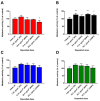Agglomeration State of Titanium-Dioxide (TiO2) Nanomaterials Influences the Dose Deposition and Cytotoxic Responses in Human Bronchial Epithelial Cells at the Air-Liquid Interface
- PMID: 34947575
- PMCID: PMC8703437
- DOI: 10.3390/nano11123226
Agglomeration State of Titanium-Dioxide (TiO2) Nanomaterials Influences the Dose Deposition and Cytotoxic Responses in Human Bronchial Epithelial Cells at the Air-Liquid Interface
Abstract
Extensive production and use of nanomaterials (NMs), such as titanium dioxide (TiO2), raises concern regarding their potential adverse effects to humans. While considerable efforts have been made to assess the safety of TiO2 NMs using in vitro and in vivo studies, results obtained to date are unreliable, possibly due to the dynamic agglomeration behavior of TiO2 NMs. Moreover, agglomerates are of prime importance in occupational exposure scenarios, but their toxicological relevance remains poorly understood. Therefore, the aim of this study was to investigate the potential pulmonary effects induced by TiO2 agglomerates of different sizes at the air-liquid interface (ALI), which is more realistic in terms of inhalation exposure, and compare it to results previously obtained under submerged conditions. A nano-TiO2 (17 nm) and a non-nano TiO2 (117 nm) was selected for this study. Stable stock dispersions of small agglomerates and their respective larger counterparts of each TiO2 particles were prepared, and human bronchial epithelial (HBE) cells were exposed to different doses of aerosolized TiO2 agglomerates at the ALI. At the end of 4h exposure, cytotoxicity, glutathione depletion, and DNA damage were evaluated. Our results indicate that dose deposition and the toxic potential in HBE cells are influenced by agglomeration and exposure via the ALI induces different cellular responses than in submerged systems. We conclude that the agglomeration state is crucial in the assessment of pulmonary effects of NMs.
Keywords: agglomerates; air-liquid interface; nanomaterials; pulmonary toxicity; titanium dioxide.
Conflict of interest statement
The authors declare no conflict of interest.
Figures






References
-
- Grewal D.S. Funding Nanotechnology—A Comparative Study of Global and National Funding. J. Nanom. Nanos. Tech. 2019;105:1–10.
-
- Potocnik J. Air quality: Meeting the challenge of protecting our health and environment. In: Bruxelles B., European Federation of Clean Air and Environmental Protection Associations, editor. International Symposium on Ultrafine Particles. EFCA; Brussels, Belgium: 2013.
LinkOut - more resources
Full Text Sources

